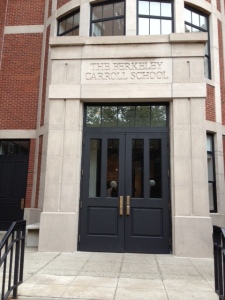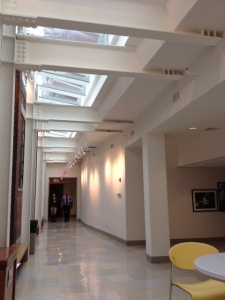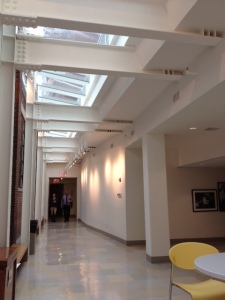Big discussions can lead to big changes, not necessarily in rapid-fire fashion, but at a more comfortable pace. This post is about a school that saw the need for big discussions, had the leadership and courage to enter the arena, and has created some profound ripple-on effects. A dam broke, not only freeing up time in the schedule to teach in ways that point to the future instead of the past, but also in creativity and mindset that has opened up remarkable learning options for the students.
 Berkeley Carroll School is a K-12 in Brooklyn with more than 800 students. I visited the Upper School, and spent a day talking with teachers, administrators and some really bright students before speaking to a meeting of the faculty. BC is just getting used to some new over-the-summer renovation, including a unique student-teacher common area where both groups work and hang out during both dedicated and unallocated free time.
Berkeley Carroll School is a K-12 in Brooklyn with more than 800 students. I visited the Upper School, and spent a day talking with teachers, administrators and some really bright students before speaking to a meeting of the faculty. BC is just getting used to some new over-the-summer renovation, including a unique student-teacher common area where both groups work and hang out during both dedicated and unallocated free time.
BC has engaged an all-school conversation about aligning learning to the school mission, which contains three main words: “ethical, critical, global”. BC is extremely intentional about ensuring that what goes on in the classroom really does reflect these three words. Liz Perry is the Director of Educational Design and Innovation (once again, do you have a person with that title at your school?). Liz says, “’Critical’ is in our mission, but what does this mean in the classroom? It means we should spend less time thinking about what teachers are teaching and more time thinking about what students are learning. When classes are about content and teachers charisma, the students are relying on the teacher too much. The world is going toward a more blended learning environment where the students need to rely on themselves and each other more.”
This alignment conversation led directly to a faculty-led discussion of the AP program. Teachers started sharing with each other their goals for students, and realized that those goals were not met by the narrow, content-focused AP curricula. They also felt that tracking students ran counter to the democratic nature of the school’s vision. As consensus grew, Head Bob Vitalo re-set the target from “will we teach AP’s?” to “what will our post-AP world look like?” Director of College Counseling Brandon Clarke said the vision directive was this: “We are no longer going to teach the AP’s. Write the best class you can that includes important topics and outcomes you want to see”. The faculty got excited about this freedom and authority and got to work. The college counselors ensure that BC has a strong school guide and clear explanation of the powerful new courses that have been created, they communicate well with college admissions offices, and the evidence is clear that dropping the AP’s has not been a negative for their college acceptances.
 By opening these doors of thinking with the faculty, BC has organically developed and adopted a series of fabulous new course options. I got to speak with both teachers and students who are involved in them; I won’t do them full justice here, so if you want to learn more, contact BC. They are all highly exportable and do not come with a large price tag.
By opening these doors of thinking with the faculty, BC has organically developed and adopted a series of fabulous new course options. I got to speak with both teachers and students who are involved in them; I won’t do them full justice here, so if you want to learn more, contact BC. They are all highly exportable and do not come with a large price tag.
Science Chair Scott Rubin and his team untracked the core science curriculum; “We should not segregate students in tracks; we can meet them where they are and it makes for better learning”. When the AP’s went away it freed up space and time for a wealth of new electives, including Optics, Bioethics, and a Science Writing collaboration with the English department. They saw modest increases in class size, which Scott insists is a positive. Scott: “If you are truly student-centric and using student collaboration, having more students is often a powerful positive. I would not want to get classes too large, but we have seen good things happen when we go from 15 or 18 students up to about 22 or 24 in a class”.
The three flagship new programs are truly exciting:
A 3-year Science Research and Design program that combines independent research and experimentation, 1:1 mentoring between students and an ensemble of faculty, peer review of research and products, and ultimately a published paper and major presentation of the students’ work in front of hundreds of members of the community. According to the students, some of whom say they don’t intend to pursue science in college; they elected to take the sequence “because I get to dictate my own learning”, and “I got interested in a topic and needed three years to look into it”. Some of the research topics now under way:
- Post-traumatic stress disorder related to HIV in rural Rwanda
- Animal behavior in captivity
- The quantum physics of time
- Artificial reef and biodiversity in the Hudson River
- Resistance of antibiotics
There were poster session displays of previous work, and I am not too proud to say that I did not even understand the titles of some of them. This is work normally done by upper level college students, which is the exact environment that this sequence emulates.
BC has formed an engineering partnership with NYU Polytechnic that allows students to go once a week after school to work in a college lab setting and experience a scaled-down college-level intro to engineering course. They work on problems in chemical, electrical, and mechanical engineering under the oversight of a Polytechnic professor and two graduate TA’s. They are taught to prepare rigorous presentation of their work, and the practice of that, according to the students, is working its way over into their other classwork. The course is done outside of normal school hours, but shows up in a special area of the student transcript.
The Chair of the Arts Department and another faculty member created an Art and Engineering class that starts with students taking things apart to see how they work and what they are made of. Then they take the pieces and create a piece of “kinetic sculpture” artwork out of them. Using CASD software they design something new and build it. According to Scott, this is a lab based on “curiosity questions, asking why things are the way they are”.
Other departments are not sitting around watching science:
 The World Languages Department has formed the first school-to-school partnership with the Johns Hopkins Center for Talented Youth, which offers online language courses in Mandarin and Arabic. BC students log in at set times during the week and take the classes, taught by Johns Hopkins faculty, and sit in cyberspace alongside each other and students from around the world. Class sizes are limited so the instructor can interact with each student, and all the students can see the instructor or his/her material in real time. They also get time with a TA every week. This language option provides huge flexibility if a students wants to take a semester off, and allows students to enter the language sequence at any level.
The World Languages Department has formed the first school-to-school partnership with the Johns Hopkins Center for Talented Youth, which offers online language courses in Mandarin and Arabic. BC students log in at set times during the week and take the classes, taught by Johns Hopkins faculty, and sit in cyberspace alongside each other and students from around the world. Class sizes are limited so the instructor can interact with each student, and all the students can see the instructor or his/her material in real time. They also get time with a TA every week. This language option provides huge flexibility if a students wants to take a semester off, and allows students to enter the language sequence at any level.
The English and Social Studies departments have adopted a combined American Studies model which gives them a double block of time all year, sometimes as much as 125 minutes in a day. A total of six faculty write the course and they teach in teams of two. Both members of the team are in the class all the time. As I interviewed the students, they had just finished a three-week experiential game designed at Barnard College where students adopt roles based on 1775 New York. The students say that the game focused on developing their skills in “persuasion, oratory, appealing to others, thinking on your feet, and resilience”. They also said they were “consumed by the game. At one point people are shouting at you and not letting you speak, acting like a mob would act, and the teacher told the mob they weren’t being tough enough! Some people got really emotional.”
All of this interdisciplinary collaboration has really started to break the silos of class and department that we know is a bulwark against 21C learning. According to two senior faculty members, a key is that at BC almost all teachers also have some kind of administrative or non-classroom role and almost all administrators teach in the classroom. They don’t have the all-too-frequent tension of “us and them” between the two groups. This made the AP discussion easier, which led several departments to seek interdisciplinary courses, which has ramped up collaboration, which has further reduced a sense of hierarchy. Untracking all the classes broke the silo of “smart and not-so-smart kids” and forced teachers to think about leveraging the power of differentiated learning, rather than sticking to one type of teaching based on a more homogenous student group in each class.
In fact, there is so much interdisciplinary collaboration, BC is starting to think about another big question: what is the role or need for a departmental structure? Chris Moses-Jenkins: “Collaboration is hard, but anything we don’t deal with as adults we put on to the kids. We owe it to them to model collaboration if we expect them to do it. Just because it is difficult does not mean it is unhealthy.”
One last set of critical insights, from Head Bob Vitalo. First, the cost of all that I have outlined above is just not a deterrent, and would not be to most schools. Bob says that the cost of 30 students in the online language program was “less than hiring one first-year teacher”, and he is paying about $15,000 a year for the engineering lab course at NYU Poly. He rightly describes costs like these as “very manageable” relative to the larger cost drivers in the school, and a small price to pay for the explosion of creativity and student options that are provided. We talked about looking at innovation through the lens of value proposition; clearly BC is creating real value by offering options that excite their customers without a large added price tag.
I asked Bob to share with us some keys to how he and BC have become more comfortable asking big questions and making big changes:
- A lot has to do with style. Bob is not an “in your face” kind of leader. He challenges faculty by saying “This would be nice to try”.
- They saw opportunities for real improvement, and took advantage of them in real time, rather than letting them simmer.
- The community is sincere about their commitment to the core of the mission: ethical, critical, and global development of their students. They seriously filter what they are doing to meet those tests.
- As a leader, his task was to bring perception and reality together, to help prove it could be done.
- Making sure smart people have the chance to work and succeed.
There is real meat at BC that we all can learn from if we are truly interested in innovation. There is no sense of revolution or turmoil, but a palpable energy and real excitement about creating the kind of learning opportunities that so many of us know are right for our students. It is not busting the bank and it is helping create value for their families. They are breaking silos and creating richer options for the learners, both adult and student. For those looking to steal great ideas, BC is rich ground!


What a great learning experience!! Sounds like some great things happening there. Thanks again for sharing some awesome learning and innovation going on here in the US Grant!!! I would love to have Liz Perry’s job! Even the title is alluring.
Yes, amazing good stuff going on at BC! And thanks for tweeting it out. Appreciate it.
There are some key components in this school that great leaders can foster in all schools. The environment encourages identifying student learning outcomes, risk taking, innovation, and thinking outside the box….all with a focus on a high level of student learning. Thanks for sharing!
My pleasure Lisa; get your colleagues to follow and share great ideas from all the schools I am reporting on!
[…] Asking Big Questions Leads to Remarkable New Student Opportunities at Berkeley Carroll, NYC « The L… […]
Mandarin and Arabic – makes total sense for today’s world! Did you meet my friend Jim Shapiro while on campus, Grant? Jim took part in the Martin Institute Master Class with John Hunter this past summer and turned out some great work!
I met the whole Upper School faculty! Great school and so much positive energy there.
Had AP credits from Berkeley (Class of ’67) plus Russian 101 sub-frosh at Cornell plus summer credit for doing field work in archaeology with Warwick Rodwell plus undergraduate program including history major and a concentration in archaeology at Cornell. Was shocked to see from my college transcript that I had 159 credit hours when 120 were required for graduation.
Good to see the shift in focus!